ॐ Vanamali's Blog
ॐ Vanamali's Blog
08/01/20
Vrindavana
This refrain from a famous song kept ringing in my ears all through the six hour train journey from Rishikesh to Mathura station. We were eight pilgrims from Rishikesh and four from Mumbai and all of us felt truly blessed to have been invited by the Lord to visit his home in Vrindavana! It is a fact that one can never go on a pilgrimage unless the deity of the temple wants to meet us and invites us. All of us rendezvoused at Mathura station and went straight to the Krishna Janmasthan which was unfortunately totally dominated by the dome of the masjid in the background. The Janmasthan is the dungeon in which Krishna was born.
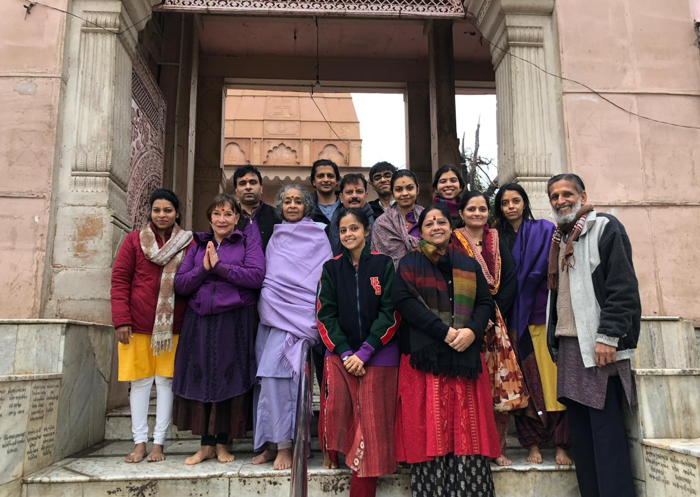
Kamsa’s dungeon has been re-constructed in a cinematic fashion and we went and sat inside. As soon as I closed my eyes I was wafted seven thousand years back to a stormy night when the Lord revealed himself to his parents Devaki and Vasudeva in the gloomy dungeon of Kamsa, King of Mathura. The baby that Devaki gave birth to had changed into the four-armed Vishnu holding the divine insignia like conch, chakra, lotus and mace. The darkness of the dungeon was dispelled by the effulgence emanating from the Lord. He told Vasudeva to deport him immediately to the cow- herd settlement of Gokula and keep him there and bring back the baby girl that had just been born to Yashoda, the wife of their chief, Nanda. With these words the effulgent form vanished to be replaced by a delightful baby. Vasudeva had no time to ask how he was going to accomplish this formidable task since he was chained to the pillar and all the dungeon doors were locked and heavily guarded. But before he could even formulate this thought the chain fell off by its own accord. He found himself free and carefully wrapped the baby in his tattered upper garment and hugged him to his heart while Devaki watched with tears overflowing from her eyes. He walked to the massive doors that swung open of their own accord. The guards were snoring, leaning on their spears. Vasudeva walked fearlessly down the dark corridors leading to the outside gate and once again found that the gates flung open effortlessly allowing him to depart with his precious burden which he clutched to his heart. It was already five minutes past midnight and the entire sky was lit up with intermittent flashes of lightning and growls of thunder. He could hardly see a step in front of him since rain was pouring down in buckets. But strangely enough not a drop fell on his head. It is said that Sheshnag, the serpent on which Lord Vishnu slept, was holding his hood like an umbrella over the head of the divine infant who was his master. He had to cross the turbulent river Yamuna in order to reach Gokula. He had no doubt in his mind as to whether he was going to accomplish this impossible task. As he came to the river, it parted to allow him to walk across with the water coming barely up to his ankles. At last he reached the village and found the house of the chief and crept into the bedroom and saw Yashoda lying there in a kind of stupor after having given birth to a baby girl. He exchanged the babies reluctantly since he was loathe to leave his precious burden but there was no time even to think so he took the baby girl who was the incarnation of the divine mother and made his way back to the dungeon. Hardly had he passed through the gate than the doors clanged shut of their own accord. The baby girl started to cry at the top of her voice as soon as he gave her into Devaki’s arms and the snoring guards woke up with a rude shock.
One of the greatest of my Lord’s lilas was played as soon as he returned to Mathura from Vrindavana at the age of twelve. Kamsa had invited all the gopalas (cow herds) to come to Mathura to take part in the great festival of Shiva’s bow but his secret intention was to kill Krishna when he came. The gopalas were simple folk and they were delighted to go to the big city of Mathura. When they reached the city the boys along with Krishna and Balrama danced and skipped along the grand trunk road leading to the palace. They were entranced by the shops and big houses they saw on either side of the road and walked along laughing and joking with their beloved friend. Suddenly they saw a strange figure approaching them. It was a girl with three humps on her back. She was so bent that she could not even look up. She hobbled along clutching a silver pot of sandal paste. She belonged to a family of devadasis, (courtesans) who used to cater to the pleasures of the great Lords of the court. She used to be known as Kubja or Trivakra since she had three humps on her back. But since she was so ugly no one ever looked at her and she was given the task of making unguents for the king. She was hobbling along painfully down the road when a pair of lotus feet stopped right in front of her and stopped her progress.
A mellifluous voice asked her, “O Sundari!” (Beautiful One) “Who are you taking this sandal paste for?”
She could not see the person but she knew he must be very special since no one had ever called her anything but “hunchbacked one” or “crooked one.”
Immediately she answered, “Who else but for you, my Lord?”
Krishna laughed and said, “Let the world see the beauty of your soul in your face.”
So saying he pressed his toe on her right foot and placed his forefinger under her chin and lifted her up, straightening up her three humps so that she stood straight and tall and beautiful in front of him. She looked straight into his lotus eyes and her own brimmed over with love. Taking the sandal paste meant for the king, she lavishly anointed the lord’s body with it. He smiled at her and walked on after his brother who was looking with displeasure at the scene. Kubja saw her saviour walk away. She could not bear to think that she would never see him again. In despair she caught his uttareeyam (top cloth) and pulled him back. He turned round with a laugh and asked, “What do you want?”
She replied, “Will you come to my house tonight?”
Touched by her offering of the only thing she had to offer, Krishna replied with great compassion, “I will come after I have finished the work for which I have come.”
She let go of his uttareeyam with great reluctance and watched him go with all her love spilling out of her eyes.
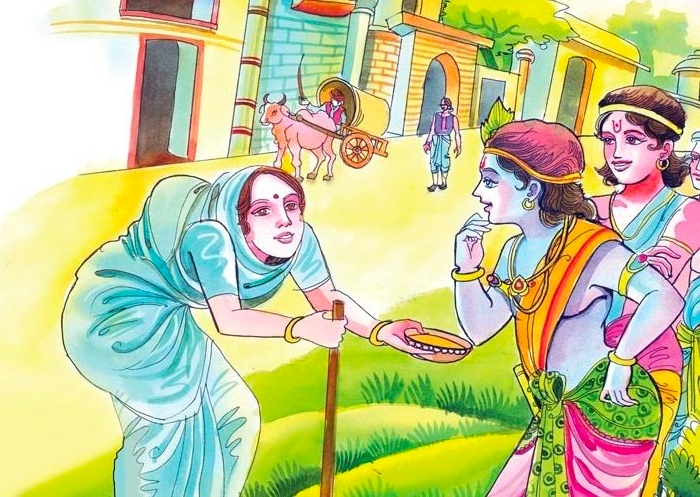 Straight after the visit to the dungeon we visited the Keshavdeva Mandir, at which spot this incident is supposed to have taken place. I was filled with delight thinking of this occurrence and the great compassion he had shown to this poor hunchback of Mathura. My eyes overflowed when I thought of the compassion he showers on all of us who are spiritually hunchbacked and totally incapable of overcoming our negativities.
It was only after visiting Keshav Deva Mandir that we went to Nanda Bhavan, the house of Nanda, in Gokulam.
RAWAL 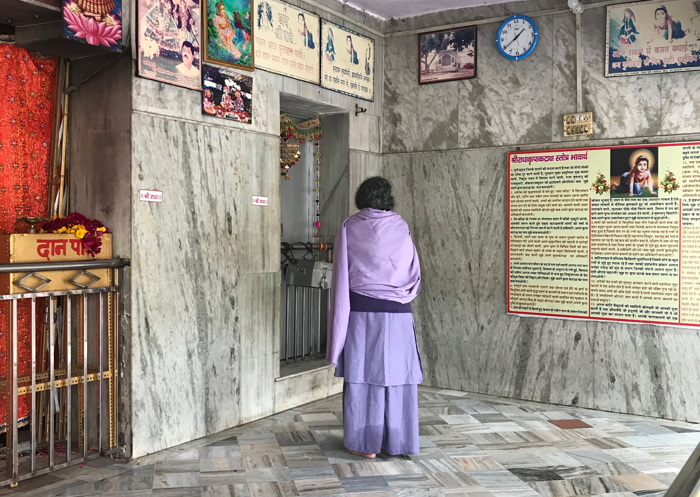 En route from Gokula to Vrindavana our guide was kind enough to take us to the little known village of Rawal, which is supposed to be the birthplace of Radha Rani. There was a simple temple there and an old man sitting and reading some scriptures and he told us the story of this place where there was a miraculous bush which had been in existence since the time of the birth of Radha. We could still see it on the roof top. The legend of this place is most interesting.
NIDHIVANA 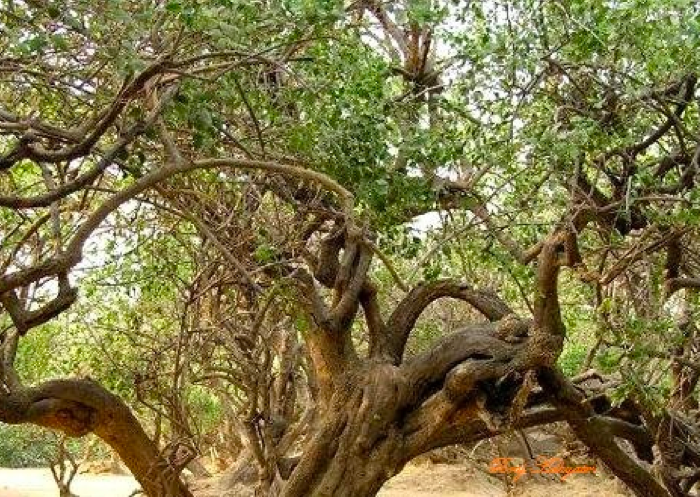 After checking in at our guest house in Vrindavana our guide suggested we visit the most famous place in Vrindavana known as Nidhivana. We reached there almost at sunset and walked through the heavily barred gates set in a high wall, leading into a courtyard. From there another gate opened out into a most mysterious garden if it can be called as such. This gate and all places around were guarded by hundreds of monkeys. We were not sure if we would be allowed to go in without being molested but thankfully an old man carrying a heavy stick offered to take us round. The small narrow path led us further and further into the secret garden. Both sides of the path were filled with ancient looking, twisted and stunted trees growing in pairs. The barks were smooth and white, the ground beneath was totally bare of all grass and looked as if it had been made smooth by countless feet stamping over it. These trees were supposed to be “van tulsi, a type of jungle tulsi”. We had been advised not to pick or take even a single leaf from them. There was a Kund at some point which again looked dark and mysterious. The winding path eventually led us to a little room called the “Rang Mahal”. There was a priest there who told us the whole story of the place. Every night after 8 pm the priest would make up the beautiful sandalwood cot inside the room. He would keep a glass of milk, a glass of water, some sweets and some “paan” (betel leaf) and a neem stick. He would then lock the door carefully and leave the garden, locking the huge door outside. No one was allowed to stay in the garden after that. All animals including dogs and monkeys would leave at that time. Even birds would not fly over the garden after sunset. Next morning the priest would return at 6.30 am and unlock the gate and the door of the room. He would find the bed ruffled up, the glasses of water and milk empty and no signs of the sweets and the paan. This is a miracle that takes place every day. It is said that the room is the place where Krishna used to attend to Radha Rani’s toilette or “Shringaar”, before dancing with the gopis. Apparently these trees are actually gopis who take on their human form and dance the “Rasa Lila” with their beloved, Krishna every night. He retires to the room with Radha and hence everything is consumed by morning. It is also a fact that these trees seem to be growing in pairs and it is noticed that they keep shifting their positions during the night. Anyone who dares to get into the garden after the forbidden hour is found in the morning to have gone totally crazy or blind or unable to articulate. They can only babble. The houses that are on the sides lock up the windows facing the garden. Some have even bolted and barred the windows overlooking the garden so that they can never be opened even accidently. This of course is one of the most mysterious places in this town filled with the magic of that most magnificent incarnation of the Lord.
RADHA RAMAN 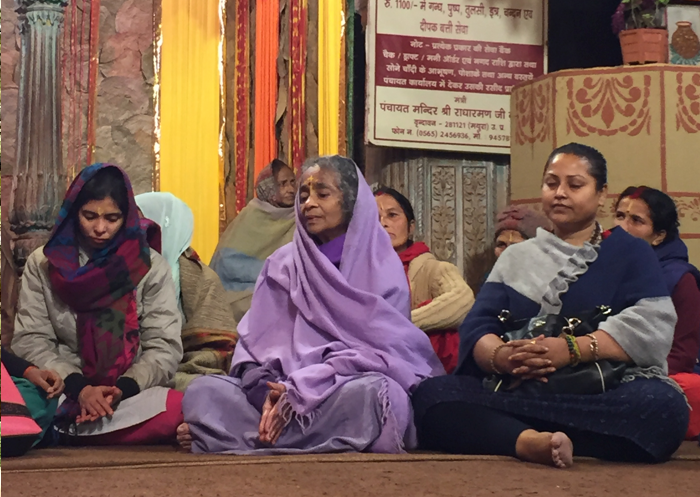 After this we went to the beautiful temple of Radha Ramana. It was a huge temple filled with devotees. The entrancing voice of the singer filled the whole hall. Everyone seemed mesmerised by his voice. I went and stood right in front of the sanctum. The two delightful idols of Radha and Krishna were far off and could only be seen clearly by using a pair of binoculars. The priests went up and down carrying offerings and garlands but I hardly noticed them. Having just come from the magic forest of Nidhivana, I was wafted into a world peopled by Radha and Krishna alone. The plaintive voice of the musician pulled at my heart strings and wafted me into the magic world of the rasamandala. I was Radha and I alone danced with him swaying in his arms to the beat of the drums playing behind me. The scintillating forms in front of me took me into an ethereal world where nothing else existed. After a long, long while the music faded, the wispy forms in front stiffened and turned into idols. Intoxicated with the glory of the place we returned to our rooms singing, “Sri Radha Ramana Hari Bol, Sri Radha Ramana Hari Bol.” Thus ended our memorable first day in the city of Radha/Ramana (the delight of Radha).
Later I discovered the history of the temple. It is one of the oldest temples in Vrindavana. One of the miracles here is that the fire in the temple kitchen has been burning continuously ever since it was lit during the time of its construction. The idol of Krishna is actually a shaligrama (type of black stone). Gopal Bhatt Goswami had gone to the Gantaki river in Nepal and brought back twelve shaligramas. He started worshipping all twelve but had an intense desire to worship the Lord in his form. One day on the day of Narasimha Chaturdashi he found that one of the shaligramas had turned into the exquisite figure of the Lord which is what we see now.
BANKEY BIHARI 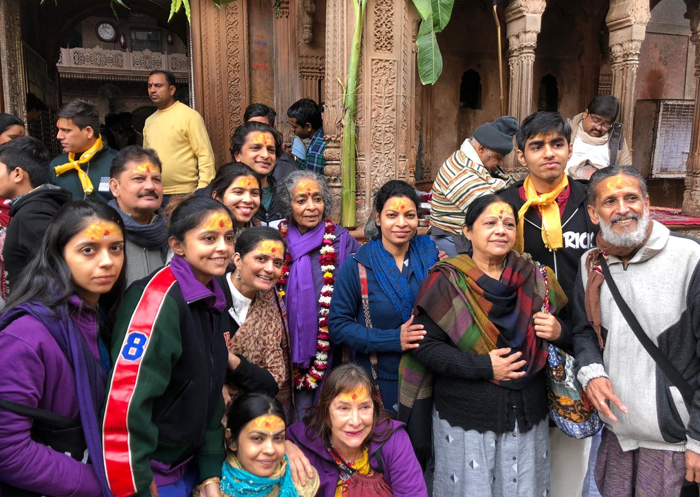 Next morning we went to the most famous of the temples of Vrindavana- Sri Bankey Bihari – meaning the one with the three bents. When Krishna stands holding the flute in his hands, he is bent in three places! This temple opens rather late in the morning since he is supposed to have spent the whole night with the gopis at Nidhivana and tired himself out! Each temple is connected with some aspect of his life with the gopis and this lends a piquant charm to each story. It was really crowded and we had to literally fight our way to the front where there was supposed to be different lanes for men and women but somehow there seemed to be no particular rule anywhere and people were simply jostling each other to get to the front. But there was a barricade of some sort right in front and we managed to cling on to the railings and lean forward to get a good view of the charming figure within the sanctorum. A priest was standing in front throwing flower garlands to various people in the crowd. I was hoping desperately that he would throw one to me and even put out my hand. Suddenly I felt a thud round my neck which nearly made me lose my balance and I found a garland of roses and marigolds round my neck. I had no idea where it had come from. I looked back and there was no one there. My eyes filled with tears and I just prostrated to him for I knew that HE was the one who had thrown the garland round my neck. I inhaled the perfume of the tulsi garland round his neck and heard the plaintive call of the flute beckoning me to go closer and closer until I melted in his arms covered in a purple haze where his eyes flowed into mine.
I sat in a daze for a while on the steps. This is a custom we follow in the south but here actually it was discouraged. However we did manage to sit for a while and absorb the vibrations of the place.
Now let us look into the history. The temple was built by Swami Haridas who is supposed to be the incarnation of Lalita, who was Radha Rani’s friend. He was the guru of the famous singer Tansen. Once he sang a beautiful song to the celestial couple in Nidhivana and found that the couple appeared before him. The Swami requested them to merge into one and this is the idol of Bankey Bihari that we see now. Swami Haridas’ lineage can be traced to Sri Gargacharya who was the Kulaguru of the Yadava clan and who had performed the naming ceremony of the baby Krishna. He had been meditating on the divine couple at the forest of Nidhivana for many years. His disciples were very curious about the place and one day they entered the Kunj. They were blinded by a bright and intense light which filled the whole place. For a few seconds they were granted the sight of the divine couple but none could stand the vision for long and feared that they might lose their sight. The swami then requested Radha and Krishna to take a single form and thus the couple turned into the one single black charming idol which we see today. The charisma is such that no one can look at it all the time so the curtains in front are regularly drawn and opened by the priests. It is said that if we gaze too long into Krishna’s eyes we will lose consciousness.
RADHA DAMODARA 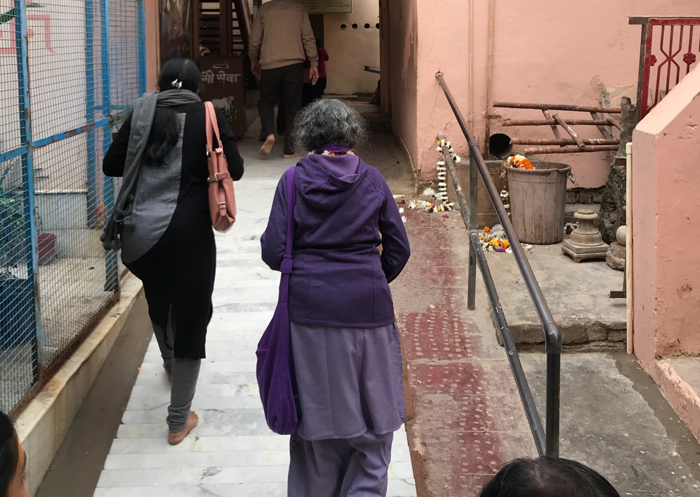 This was quite a big temple with a garden at one side and a library at the other. The beautiful idols of the Lord and Radha were already clothed in their deep blue winter garments. There was a very interesting story connected with this temple. One of the Goswamis called Sanatana Goswami, had been doing four parikramas (going round) of the mountain of Govardhana that Krishna had lifted and held up as an umbrella over the gopalas and gopis when rains threatened to flood the whole village. The Goswami kept doing this till he became too old to walk. At that time the Lord manifested himself as a small mound at this very place and told him that from now on he need not go to Govardhana to do his parikrama but could do it round this mound. This mound is known as the Giriraj Charan Shila and has Lord Krishna’s footprint on it since he is supposed to have stood on it. It is now covered with a beautiful cloth and the priests uncovered it now and then and exposed it to all the pilgrims. It is right in front of the charming figures of Radha and Krishna. We were told that we would get the same benefit of doing circumambulations of Govardhana if we went on the walking path round the temple. We were thrilled to hear this since we knew that we certainly did not have the time to do the real parikrama of the mountain. This was truly a bonus. Chanting Krishna mantras we went round and round on the little path and just as we completed the 4th round, the curtains that had been drawn in front of the sanctorum for the main puja, lifted and enabled us to see the mid-day Arati (waving of lights). In each temple my Vanamali had arranged a small miracle.
History has it that this temple was established by Jiva Goswami in 1542 AD. During the time of Aurangzeb the idols were removed to Jaipur was some time and brought back in 1739. He established a library here where all the original manuscripts of the Goswamis are stored. Some of these have been preserved.
ISKCON TEMPLE (International Society for Krishna Consciousness) 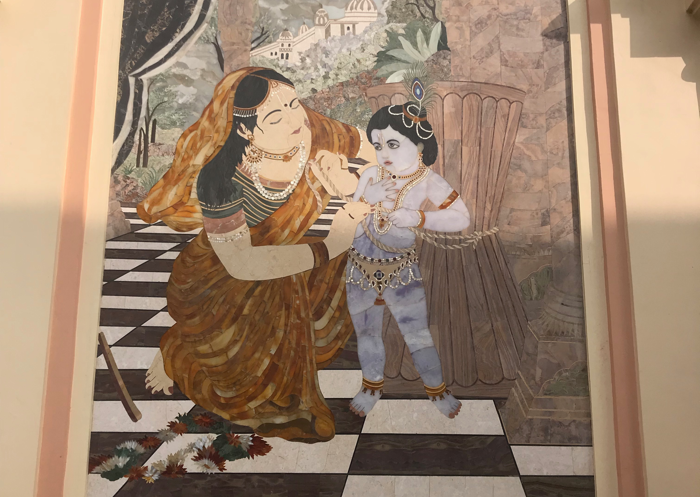 Next we went to the famous Iskcon temple. It was very beautiful with fantastically decorated figures of Radha and Krishna in the middle, Sri Chaitanya Mahaprabhu and Nityananda on the left side altar and Sri Prabhudananda on the right side. Since the noon Arati was going on, there was a lot of dancing and singing by the devotees in which all of us joined in with great delight.
After this we partook of the Krishna Prasad which was served at their restaurant reserved for visitors.
MIRABAI 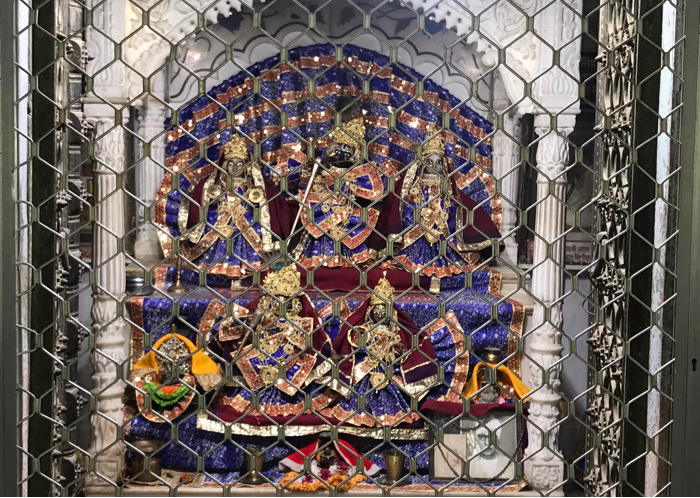 Our next stop was at the comparatively small temple of Mirabai, the princess of Mewar who was married to the prince of a neighbouring state at a very young age. She had given her heart to Lord Krishna and could never have a proper relationship with her husband, who suspected her of having illicit relationships with some other man. He didn’t dream that it was Krishna himself who was her sole love and husband. Instigated by his jealous sisters he repeatedly tried to kill her but of course the Lord saved his devotee time and time again. At last she decided to leave the palace and made her way to Vrindavana. When she tried to enter the hall where some great pundits were carrying on a debate about the Lord’s exploits, she was stopped. They shouted at her and declared haughtily that women were debarred from entering that place. Meera looked around at all of them and innocently asked, “Where is the man here? I see only women. There is only One Purusha (male) in this world and that is my Lord Giridhari. Everyone else is a woman!”
This is the spot where this episode took place and her temple was built here.
I suddenly noticed a young man in full prostration in front of the idol. Something about him attracted me and I waited for him to get up. However he did not rise up for a long time. I turned away and told one of the boys to give him some money since he was dressed very poorly. However when we searched for him, he was no longer to be found. Since I was standing at the door there was no way he could have slipped out without one of us noticing! Another question mark in Vrindavana?
Meera Bai went to Vrindavana in the year 1524 after leaving the palace of her husband. She lived in Vrindavana from 1524 to 1539. After that she went to Dwaraka and stayed there till her death in 1550. In Vrindavana Krishna is always found with Radha and the bhava (attitude of the mind) here is that of a lover and his beloved. In Dwaraka however, Krishna is worshipped as the husband of Rukmani and his various wives. Meera always considered him as her husband. Perhaps that is why she left Vrindavana and went to Dwaraka.
TATIYA STHAN 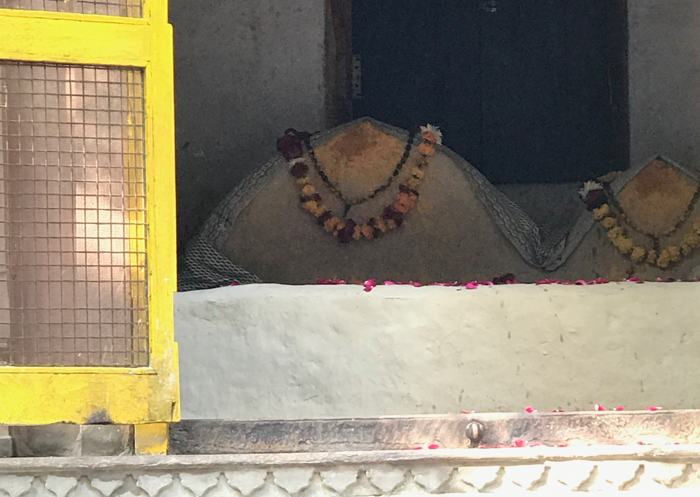 The great sage and Acharya known as Lalit Kishori Devji lived between 1758 and 1823. He was anxious to meditate in seclusion under a tree. His disciples found a place and fenced the whole area using bamboo sticks. Bamboo sticks are known as “tatiya” in the local dialect. This is how the place got its name.
When we went there it was already quite dark and we could hardly see where we were walking since the place was lit only with a few “diyas” (mud lamps) placed here and there that had flickering lights, casting grotesque shadows on the sand. The whole place had been preserved exactly as it had been at the time of the great sage. I was wafted a couple of centuries back. It was a magical place. There were no large, ugly concrete edifices. There was only a huge square of river sand in which our feet sank deep. Apparently the sage had never left this square of sand and never ventured out of this self-imposed prison. It was fenced with bamboo sticks and filled with various kinds of trees that Krishna loved like neem, peepul and kadamba. This place is meant only for sadhana (spiritual practice) and is not intended to attract the normal tourist.
His samadhi was in a small room in the centre of the square. Thankfully the place had not been electrified. We sat in front of the samadhi in almost complete darkness. It was a most mysterious place filled with strong vibrations. Soon a couple of men came and sat in front and started singing some wonderful verses about Krishna. It was really thrilling. Tears poured down my eyes as the soul stirring couplets reverberated through the air. We sat in silence soaking in the atmosphere of devotion that filled the place. Our guide then told me that the Madhathipati (chief of the ashram), had come there and I could take the opportunity to meet him. I followed him round the samadhi temple and came to a platform about two feet high, again made totally out of sand that had been firmly stacked and was most stable. A cloth had been spread over it and the priest sat quite firmly on it. He gave me some Prasad (food that has been offered to the deity) and told me to come in the morning the next day. We did go again the next day but the aura and mystery surrounding the place had been overpowering at twilight and was hardly perceptible at 11 in the morning. But we did have a good look inside the samadhi room which had just two plain mounds, one for the saint and the other for his disciple.
YAMUNARATI 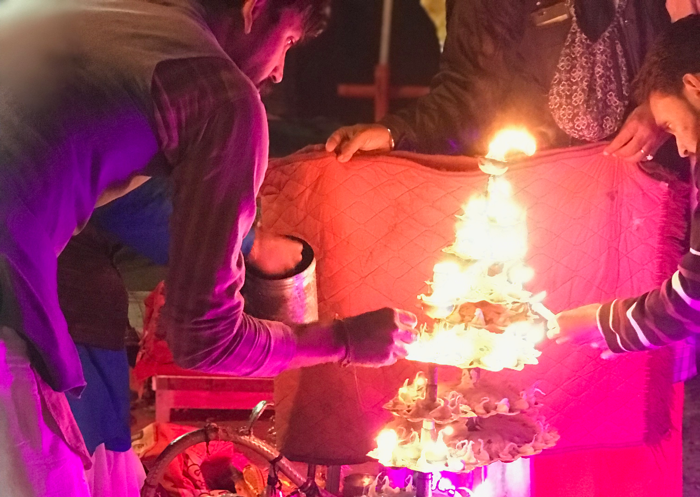 From there we went straight to the banks of the Yamuna to watch the famous Yamunaarati. There was a kind of a platform above the Yamuna on which the priest and various helpers were seated in front of a makeshift altar. He had a beautiful voice and was chanting innumerable songs. A lady dressed like a gopi was dancing and singing at the side. The Yamuna was only a dark expanse of water at the back. Suddenly the darkness was lit by thousands of little lights floating down the river. The little lamps were placed in boats made of leaves and filled with flowers exactly as we used to see in Rishikesh on the Ganga. At the end of the long drawn out puja each of us were given separate arati plates and lamps and asked to perform our own aratis to the river goddess.
My heart bled for the holy river. Our ancient sages were so wise that they taught us to worship our rivers like goddesses since they knew that rivers were the lifelines of our country. However today we have forgotten this truth and have clung on to the surface rituals which are meaningless without the basic truth that supports them. After the pujas are over, the plastics, the flowers, the papers and the rubbish are all thrown into the “holy” river as if she was a garbage bin! All the little nalas (drains), collecting the refuse from the big hotels and bustling city were all released into the river which was slowly being choked to death. “Why are we killing our rivers like this?” I cried out. Why are we clutching at the empty shell of the rituals without realising the reason for their being? Our rivers are screaming out loud to save them. We have shut our ears to their cries and keep on with our meaningless rituals, uncaring of the fact that we are actually committing suicide since without our rivers we will be lost!
KARTHYAYANI TEMPLE 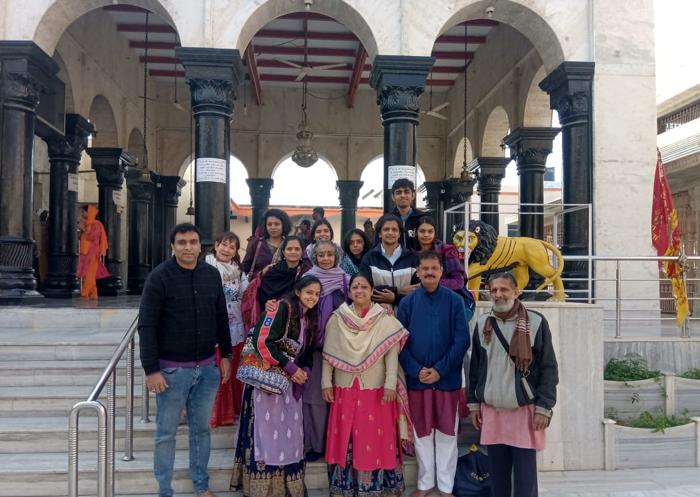 On the third day morning we went to the Karthyayani temple which was a fairly new temple built by Swami Keshavananda who was a disciple of Lahiri Mahasaya, which Paramahamsa Yoganandaji had visited. Keshavananda spent forty years in the Himalayas. There he had a vision of the mother goddess Karthyayani and went to Vrindavana and located the place where the gopis had prayed to Devi Kartyayani and built this temple.
It had beautiful vibrations and as we sat in front I was reminded of the touching story of Devi Karthyayani which is given in the Bhagavad Purana. She is the primeval Mother Goddess and the gopis who were totally enamoured of Krishna decided to undertake a forty-one day vow to her in order to procure him as their husband.
In the month of November they would get up at Brahma Muhurtam at 4 am and go to the River Kalindi in the bitter cold. They would take a bath in the icy waters and then make an idol of the goddess Karthyayani with the river sand and worship her with this mantra.
“Karthyayani Mahamaaye, Mahayogin, Yatheeswari, Nandagopa sutham Devim pathim me kuruthe mama.” (O! Devi Karthyayani! Thou art the great Mother goddess! The controller of maya, the great yogini!
Do thou grant us our wish and give us the son of Nanda (Krishna), as our husband.)
Hundreds of gopis used to gather together on the river banks and repeat this mantra and pray earnestly to the goddess to give them Krishna as their husband. This went on for forty days. On the forty-first day, the object of their desire presented himself before them on the river banks. They were thrilled to see him but a bit shy since they were naked so they sank down to their necks in the water. Their clothes had been discarded on the banks. Krishna picked up the clothes and casually climbed up a tree and hung the clothes on the branches. The gopis didn’t know what to do since they were stark naked. They begged him to return their clothes but Krishna refused and asked them to come out one by one with their arms raised above their heads and he would give them their clothes.
This is one of the most mis-interpreted episodes in his life. The gopis had actually reached the very pinnacle of excellence as far as devotion was concerned. They cared nothing for themselves and were ready to sacrifice everything, even their own relations for his sake but they still clung to the body as if it belonged to them. This test was given to them in order to make them realise that they were not the body. We are ashamed to expose our bodies in front of another person but Krishna is not another person. He is the very breath of our breath, the life of our lives, the supreme atman, ensconced within the covering of our bodies. Our body is his temple. This is the truth he wanted to teach them - that he was not separate from them so there was no need for them to be ashamed to expose their bodies in front of him. This was the final test given to them before he agreed to their demands which was to have him as their husband.
One by one the gopis came up to the Lord of their hearts and accepted their garments from his hands. He had tested them to the utmost, made them dance to his tune, run for him, cook for him, dance for him, play with him, do everything for him and now he had made them realise that they were not separate from him. He was their very self. Pleased with their unconditional love and devotion he blessed them and told them that he would meet them in the forest on the next full moon day- which was the Sharad Pournami when the moon would be at its its largest. That was when he danced the “rasalila” with them.
This is one of the most esoteric of his lilas and all of us felt exalted when we listened to this story. All of us prayed to the goddess Karthyayani to give us Krishna as our husband!
RANGANATHA 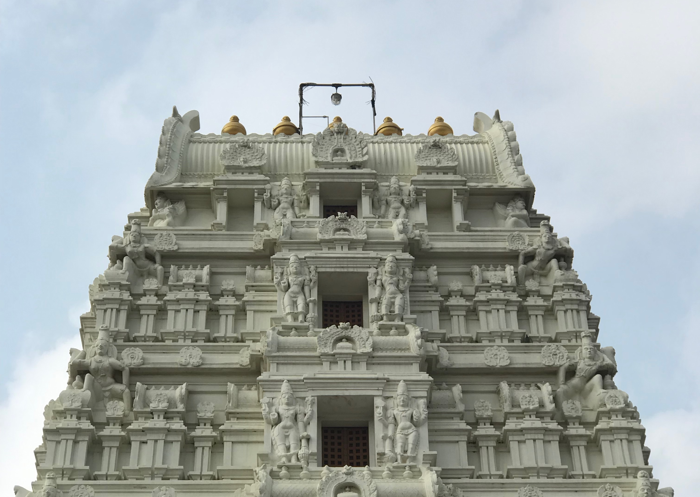 From there we went to the Ranganatha temple which is the biggest temple in Vrindavana with huge grounds. It is one of the few temples in Vrindavana, built in the South Indian Dravidian architectural style. The main priest is always a South Indian.
It was built in 1851 by a Jain businessman. The main deity is Ranganatha, the deity found in Sri Rangam in Tamil Nadu. The temple had closed for the mid-day puja so we sat in the beautiful gardens and meditated till the huge doors opened. We went in and were just in time for the noon Aarti. It was so perfectly planned that we felt truly awed. It was a huge and very beautiful idol and we were able to pray without any crowd for a long time before they asked all of us to go out since the temple was closing for the afternoon. It was the wedding anniversary of a couple in our group. He was a S.Indian who had great faith in the deity so they were so happy to have had the great good fortune to have darshan of his favourite deity on this auspicious occasion.
We came out on the road and were surrounded a group of widows for which Vrindavana is famous. Many of them wander around in the streets begging for food or money. We asked them to come with us and the couple took them to a restaurant and gave them a good meal. Feeding the poor is supposed to be the most auspicious thing to do on an anniversary or birthday. So it was their great good luck to have been able to do so. We also bought some shawls and distributed it to them. It was such a delight to see how happy they were. We were so grateful to Krishna for having given us this opportunity.
GOVINDA DEV TEMPLE 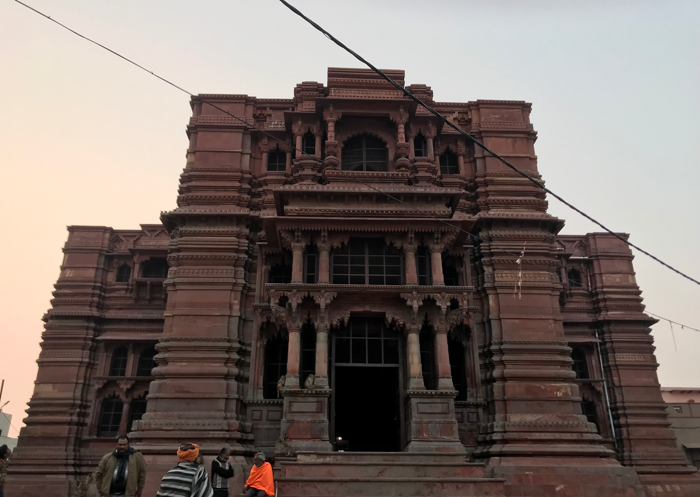 This temple is said to be one of the oldest and believed to have been installed by Vajranabha, Lord Krishna’s great grandson more than five thousand years ago. But the deity was lost over a period of time. Once when Rupa Goswami was searching for the deity he sat under a tree near the Yamuna banks. He was approached by a gopala who told him that he had seen a cow go up the hill daily and pour milk into a hole. The Goswami went and dug near the hole and found the beautiful idol of Lord Govindaji. He requested Raja Man Singh of Jaipur to build a temple. He built it in 1590. According to the legend it is said that Akbar had donated some of the red sandstone that had been brought for constructing the Red Fort in Delhi to Raja Man Singh who was his general. It was destroyed along with so many of the temples of Vrindavana by Aurangzeb. The idol was taken and kept in Jaipur. It was later re-installed during the British rule in 1873.
GOPESHWAR 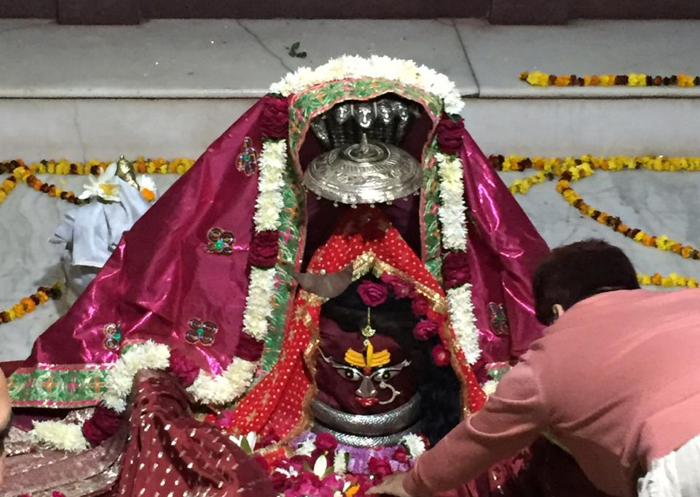 This was indeed a unique temple, one of the few Shiva temples in Vrindavana. The story goes that Lord Shiva was anxious to see the rasalila of Lord Krishna. On full moon day of the Sharad season he arrived with Parvati in the forest of Vrindavana to watch the fun. In this dance the gopis would make a circle with Krishna standing in the middle playing the flute for the dance. But the miracle was that every gopi had her own Krishna as her dancing partner! Shiva was very anxious to witness this particular lila of the Lord. He tried to slip in unnoticed but this was naturally quite a difficult task for the blue-necked one. Shiva was determined to participate in it and so he meditated with Radha in his mind. Pleased by his meditation, Radha sent her close friend Lalita to bring him over into the Rasamandal after he had a dip in the holy Yamuna. When Shiva took the dip, he came back as a beautiful damsel and Lalita took him to the Rasamandal. Lord Krishna recognised Lord Shiva and named him as Gopeshwar. Shiva considered Lalita as his guru since she helped him understand the secrets of the Rasalila.
THE GOSWAMIS No description of Vrindavana would be complete without mentioning the six Goswamis to whom the world owes a debt for they are the ones who brought out the esoteric secrets of the transcendental lilas of the Lord and disovered the places where the rasamandala was held. Almost all the temples of Vrindavana were built by them. They were a group of true sages from the Gaudiya Vaishnava tradition who lived during the 15th and 16th centuries. All of them came from affluent families but gave up everything and came to Vrindavana as directed by their guru Chaitanya Mahaprabhu who is considered as Krishna’s yugavatara (Incarnation of the age).
The two brothers Rupa and Sanatana Goswamis were told by Chaitanya Mahaprabhu in the year 1516 to go and live in Vrindavana and search for all the holy places connected with Krishna’s transcendental pastimes. The brothers were actually important ministers in the government of Bengal but at the behest of their guru they renounced their mundane life and went to Vrindavana which at that time was only a large forest. They wore nothing but a loin cloth and slept under trees. They ate only roots and dry chappaties (unleavened bread) obtained by begging in the nearby villages. They hardly slept for more than two hours and spent their time in meditation and writing books on the science of Bhakti Yoga. They wrote on parchment leaves which have been preserved in the Vrindavana Research Institute. The two Goswamis Rupa and Sanatana were assisted by Raghunatha Dasa, Raghunatha Bhatta, Gopala and Jiva Bhatta from the south, and these form the famous six Goswamis of Vrindavana. Their fame came to the ears of the Moghul Emperor Akbar who decided to pay a visit to Vrindavana in 1570. Jiva Goswami led him blindfolded into the sacred forest known as Nidhivana where he experienced such bliss that he granted permission to construct four grand temples dedicated to Krishna. These are the temples of Govindaji, Gopinatha, Madan-Mohana and Jugal Kishore. He also gave money to set up a library at the Radha Damodara temple to preserve the writings of the Goswamis. He gave the best red sandstone normally reserved for the Emperor’s palaces to make some of the temples. Unfortunately one hundred years later in 1670, all these temples were desecrated by his grand-son Aurangzeb.
MADANA MOHANA 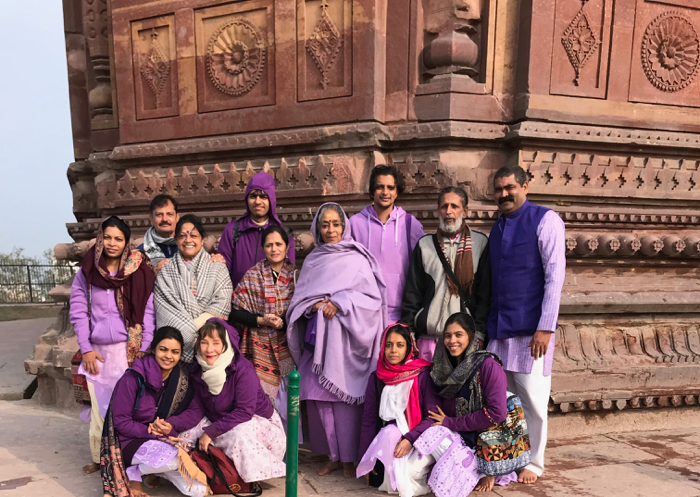 This temple is said to be the oldest in Vrindavana. The idol of Krishna known as Madana Mohana (the enticer of Cupid) was discovered by Sanatana Goswami. The idols of Radharani and Lalita Sakhi are also found here. It was built in 1580 on a fifty foot hill called Dwadasaditya Tila. Every day we would pass this temple to which our guide had been hesitating to take us since he thought I might not be able to climb. When we assured him that I could manage it, he decided to attempt it on the 4th day of our soul uplifting pilgrimage. It was not much of a climb and we were really glad to have made it. It was under construction and had been declared a Hindu Heritage temple. I’m never very happy to hear this since most of the temples that have been taken over by the government in this way lack something. Even though the grounds are maintained very well the fact is that there is no priest or proper pujas conducted at such temples. So they look like beautiful mausoleums. The spirit of the temple is missing. This had not come to this stage but the priest was rather a lackadaisical person. As I said the grounds were well kept and a lot of construction was going on, which made it difficult to do a full parikrama of the temple. However we did find a very sweet sweeper lady who was so happy to see us and of course her name had to be Lalita (Radha’s best friend and confidante!), whose idol is to be seen in the temple. This was another of the puckish pranks my Lord loved to play with me.
SEVA KUNJ 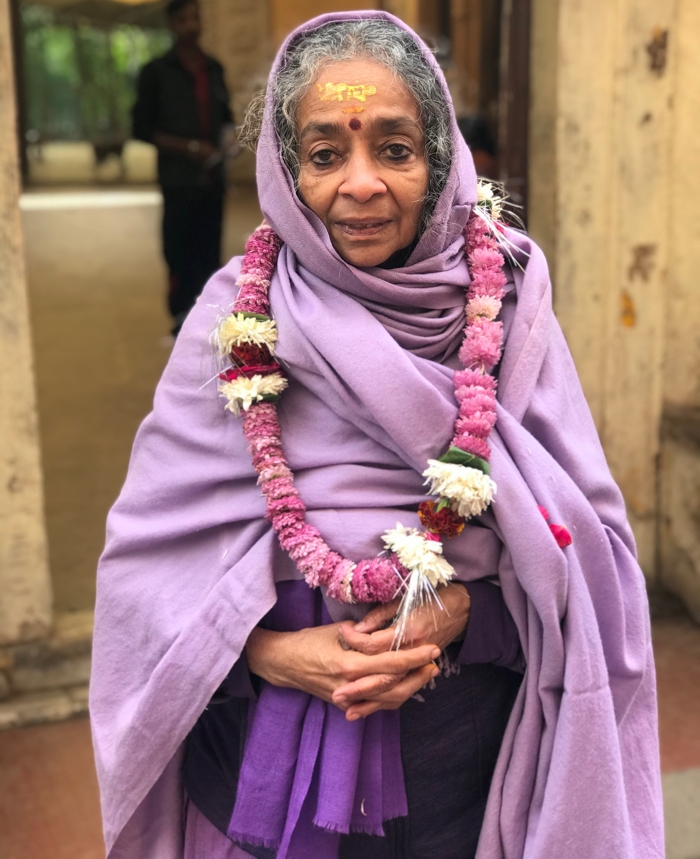 This was another weird place something like Nidhivana. Since it was bright daylight it didn’t have the magic and mystery of Nidhivana. I don’t know what made our guide insist that we visit this place. He was always prompted by Vanamali himself. His instincts were so deep and unpredictable that I’m sure he had direct contact with Vanamali. We went to the little temple in which there was an avaricious priest who as usual gave a long drawn out explanation of how this was the place where the rasalila used to be performed. The temple walls were decorated with paintings of the various lilas performed by my Lord. In one he is seen to be combing and decorating Radha’s hair. But what made me take instant notice was the painting in which Krishna had taken Radha’s foot onto his lap and was tenderly massaging it. This is why this place is known as Seva Kunj since Krishna used to do seva (selfless service) to Radha and help her to get ready for the Rasalila. There is also a well here which Krishna is said to have made for Lalita.
We went and sat in the courtyard in front and sang some songs but all the time this picture was haunting me. Suddenly a sweeper carrying a huge broom in one hand and a garland with lavender coloured chrysanthemums in the other, came in front of us and garlanded me. I couldn’t believe it. Who was he? From where had he suddenly appeared with a garland? What was the story of this place? I closed my eyes and they overflowed with gratitude towards my Lord who had appeared in so many forms and had accompanied me to this holy spot. All these boys and girls were nothing but gopis. Everything was Krishnamayam (filled with Krishna). I was overwhelmed with a deep sense of gratitude to each and every one of these noble souls who had accompanied me and were anxious to serve me in any way they could. If my Lord could massage Sri Radha’s feet as recompense for her unconditional love and devotion to him, could I not touch the feet of these pure souls who had taken on human forms and who were actually gopis in disguise. Each one of them in their own way had done so much for me. How could I ever repay them for their loving service? I was filled with a desire to touch their feet on this holy ground and thus repay my debts if indeed that was possible. It was not a logical thought. It was a spontaneous action prompted by Him alone. One by one they came forward ignorant of what they were called for. I could hear the tinkling of their anklets as they came and each of them was covered with a purple haze, some of which enfolded me. I was choking with some uncontrollable emotion of love and gratitude. I touched each one’s feet reverently and placed the dust on my head. The love I bore for each of them could only be compared to the love that my Lord had for the gopis. As Uddhava said in the Bhagavad Purana – “Blessed is this land! Blessed is the dust of this place on which that holy one has trod. Blessed are the shrubs and trees for his clothes have brushed them as He walked!”
Uddhava then took the dust of that holy ground on which the gopis were standing and placed it on his head and said, “Blessed are these gopis of Vrindavana for the dust of their feet is capable of purifying all the three worlds!”
If Uddhava, the Prime Minister to the king, the most erudite person of the age could have felt this, what wonder that I, who was only a servant of the devotees of the Lord, could feel overwhelmed with love for these gopis who had followed me to this holy land?
I could have rolled on this ground – this holy ground on which my Lord had walked, on which the gopis had walked, on which so many saints had trod! I felt inebriated like a bee that had drunk deep from the nectar of the flowers of the Vanamala that hung round my Lord’s neck and I could hardly stand. The haunting music of his flute was driving me crazy. I knew that my only salvation lay in his divine arms.
“O Vanamali! My only Love! I surrender totally at thy feet.
ANANDA WIDOWS ASHRAM 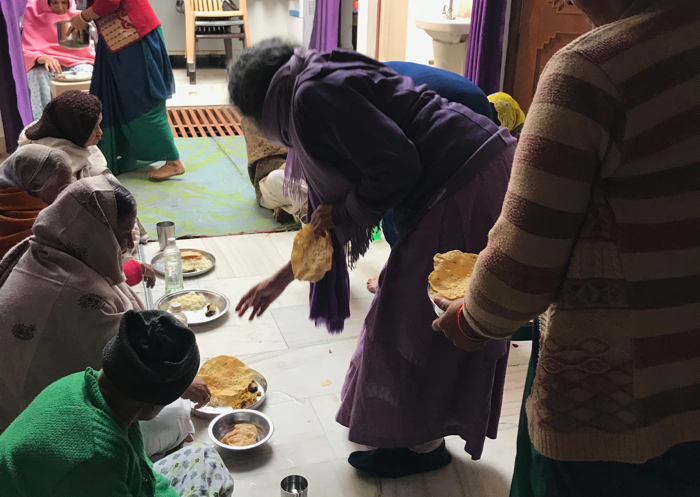 None of us felt like going anywhere after this. The Ananda Widows ashram had been kind enough to allow us to donate the lunch for 178 widows that day. Silently we proceeded to the place. Compared to the widows we had seen on the streets the previous day, here all of them had lovely beds, and extremely clean bathrooms and kitchens etc.
Most of them were Bengalis and all were very old. Bengal in the past century had very strict laws concerning widows. Though they were treated as queens while their husbands lived they were considered to be most unlucky the moment their husband died. Their own parents refused to keep them in their houses and many of them were taken to the widows ashrams in holy places like Kasi and Vrindavana where they were left to manage as well as they could. The government had provided some sleeping quarters for quite a few of them but they had to fend for their food by begging on the streets. They were given a petty sum by the temples for singing bhajans during arati.
So it was a joy to see this well- looked after and happy widows at the Ananda Ashram. We were taken round each of the beds and I felt so happy to observe their joy and the way those in charge dealt with them. They seemed to be filled with love. Their own children had abandoned them and the love which they could not give to their children they lavished on these pure souls who had dedicated their lives to serving them. We were all deeply touched by this scene. We went to three of their ashrams and blessed the food. I felt deeply honoured to be asked to serve the food at one of the ashrams. The rest of the group distributed sweets and chocolates. After all the inmates had their lunch, we also sat on the floor and partook of the delicious lunch that had been cooked in true Bengali style.
After this we went to their office where we had sat- sang with all the office bearers. Jayeeta Chakraborty, the one who was in charge of the ashrams was such an inspiration to us. She had dedicated her whole life to these people and since she spoke the language of the majority, she could converse so easily and sweetly with them. It was obvious that all of them adored her. I’m truly grateful to her for having helped us in so many ways during this trip. Rajeshji was the guide that had been given to us. Within a few hours he became not only a guide but a friend and true devotee of Vanamali. He was such a pure soul. All of us felt blessed at having him with us all the time.
GIRIDHARI DHAM 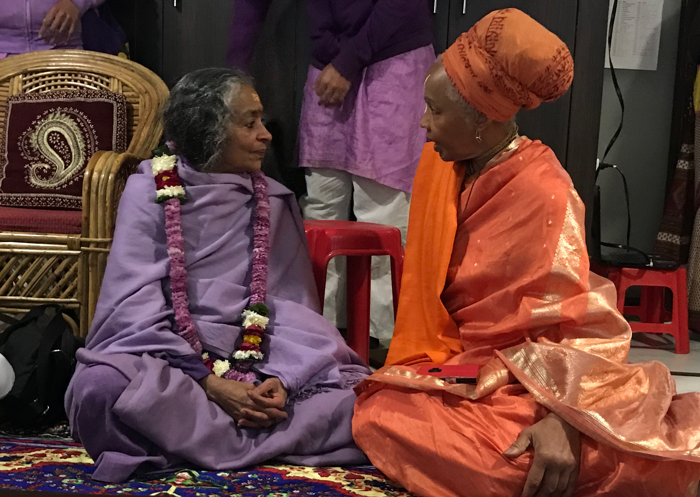 We had been invited to visit the Giridhari Dham so on the way back to our guest house, we went there. Most of the inmates were foreign devotees. Somehow they discovered that it was my birthday and insisted on singing songs and giving blessings. It was a delightful end to the day. One of them who was from Canada asked my opinion about what they should do in that city. Without hesitation I told her that the one way they could help the city would be to clean it up. I told them to offer 1 kg of rice or atta for a kg of plastics and I assured her that they could get the place cleaned soon enough.
“India’s role in society is to provide spirituality and in turn it’s your role to teach us cleanliness. There are many people who go round chanting bhajans but I think Krishna would love you even more if you undertook the great task of cleaning up the city.”
She was quite impressed by this and promised to take up the challenge. I hope they will do it.
GOVARDHANA 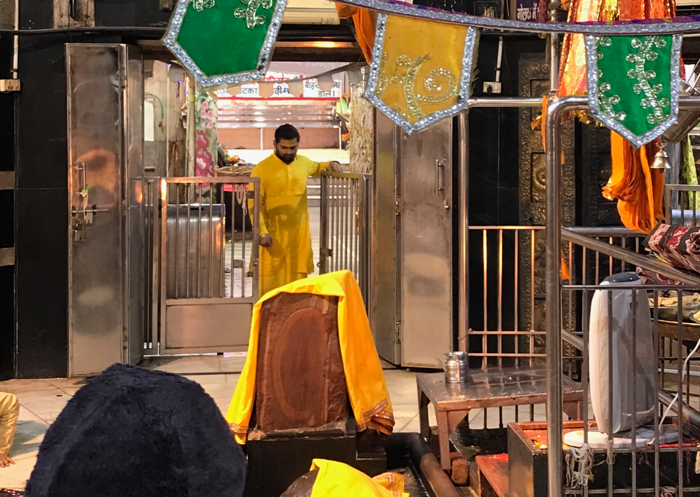 On the last day, despite my hints the party was anxious to visit the site of the famous Govardhan hill where Krishna had performed one of his most prominent miracles. The cowherds were a pastoral race and were always anxious to please Indra, the god of rain, for their entire livelihood was bound up with the cows that lived on the pastures and green grass that depended on rain. Once when they were preparing for the festival meant for Indra, Krishna went up to his father and advised him that worshipping the hill Govardhan was better than worshipping Indra. This was the hill that stopped the rain clouds that shed their store of water on their pastures so worship should be given to the hill was Krishna’s argument. Nanda and the others reluctantly agreed and all of them took all the delicious eatables they had prepared and went to the hill and offered their worship. Indra saw this and was furious. He let loose his flood waters and the little village started to drown in the rising deluge. The terrified gopalas ran to their saviour. Krishna told them not to worry and that Govardhana would save them. He lifted up the mountain as if it was only a huge mushroom and the gopalas and gopis and the cows took all their possessions and stayed for one whole week under this amazing umbrella. Indra could not believe that such a small boy was capable of holding up a mountain but at the end of a week when he had exhausted all his stock of water he realised that another star had risen in the heavens who was going to usurp his throne. He repented his behaviour and went to Krishna along with the celestial cow, Surabhi and extolled him and begged him to forgive him. Surabhi requested to be allowed to pour her milk over him in the very first “abhisheka” or pouring of some liquid over a deity. He agreed and Indra performed this task and everyone extolled Krishna by a new name – “Govinda” or the Indra (king) of all creatures and cows in particular.
This incident also represents the fall of the ancient Vedic gods of whom Indra was the king. That used to be a kind of sacrificial worship and Krishna brought in the jnana-bhakti marg – a combination of knowledge and devotion. He has dominated the spiritual scene since his advent and has been classified as the supreme incarnation.
Govardhana hill is supposed to stretch from Radha Kund to the end of the so called hill which is actually only a long ridge that stands about 30 m above the surrounding land. The hill has apparently been decreasing by the size of a mustard seed everyday due to the curse of the sage Pulastya.
Once, the great sage was travelling over the world and landed in Shyamali Dvip (now called Africa). There, he saw Mount Drona’s son Govardhana filled with flowering bushes and fragrant vines heavily laden with fruits. It had minerals and jewels. It looked auspicious with many caves and streams. Different kinds of birds were fluttering around filling the air with their cooing sounds. He thought Govardhana would be an ideal place for performing austerities and requested Mount Drona to allow him to carry his son, Govardhana to Kashi, the city of Shiva. Drona was not anxious to let his son go but fearing the curse of the rishi he allowed him to go to Bharatavarsha (India). At that time Govardhana was 103 km long, 64 km wide and 26 km tall. The hill warned him that if he ever put him down he would not budge from that place. The sage agreed and carried him in his right hand through the air. As they passed Vrindavana, Govardhana knew that this was the place where Lord Krishna was going to spend a part of his life. He wanted to stay there so he made himself very heavy so that Pulastya was forced to put him down. He begged the mountain to climb back on to his palm once again but he refused. The sage was angry and cursed him that he would daily become smaller by the size of a seseme seed. This has come true and today it is just a ridge 8 km long 25m high. It has been declared illegal even to pick the tiniest pebble from this.
I had been there before and knew that that there was no hill anymore. However just to quench their curiosity we went to the temple there and saw the little mound that was all that was left of the hill. The temple to Govardhan was beside the beautiful Mansi Ganga. But the rest of the place was kept in a very dirty condition. This always saddens me and I hope the westerners of Giridhari Dham would take up the cause.
From there we went to another Yogananda Trust for widows at a place called Radha Kund. This was indeed a beautiful Kund where many people were taking baths. The street leading to the Kund was filled with shops all selling tulsi malas of every size and description. This was apparently a cottage industry here and every house in the village had tulsi bushes and made the malas themselves.
That evening we had our final arati in our guest house. It was a touching scene for all of us and we felt bound to each other by the strong rope of our love for our Beloved Blue Boy of Brindavan. May that bond remain forever in the heart of all the gopis who had come on this pilgrimage.
O Radha! Beloved of Krishna! Lead us Shyam, the dark darling of the world!
Radhe! Radhe!
Shyam Milade!
25/10/19
DIWALI
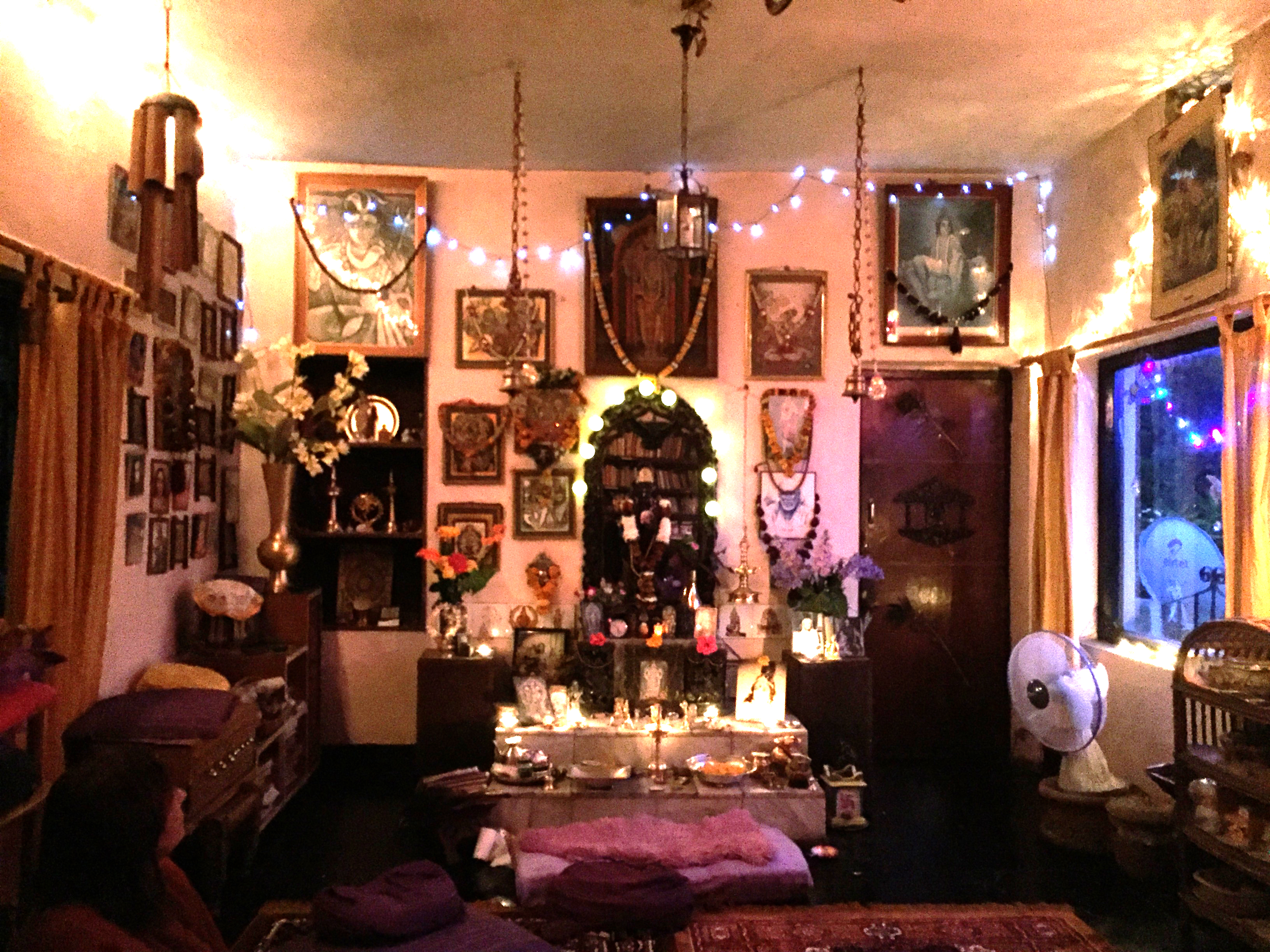
The Bhagavad Gita says: “The sun does not shine there, nor the moon, nor stars or fire.” What does this mean? Just as the light of a small candle pales into insignificance before the light of the sun, so also all the lights of this universe cannot be compared to even to a spark of the effulgence of the Brahman. That effulgence is ever burning within us and all around us. All we have to do is to remove the darkness of many births passed in ignorance and allow that light to burst out in all its glory. IT is ever enshrined in our hearts but the brambles and bushes of our abysmal ignorance cover IT. If that light was not within us, no amount of external lights would allow us to see this world of multiple phenomena which is actually a shroud which covers the face of the creator. Diwali is the festival of lights in which we are told to remove this ignorance by lighting the lamp of wisdom within us. This festival is celebrated on the night of the new moon. The new moon signifies the darkness of ignorance in which all of us are enshrouded. Since it’s such an important festival for the whole of India all the religions in India except the Abrahamic religions have woven a story about it into their own scriptures. It is celebrated by several other religions including Jainism, Sikhism and numerous folk religions. They have different mythological versions of the same tales. Jainism, India’s sixth largest religion, hails this as the day on which Lord Mahavira, the last of the twenty-four Thirthankaras (Great Teachers) attained ‘Nirvana’ (enlightenment). While most traditions surrounding Diwali go back thousands of years, one of the most recent traditions associated with it is the one in Sikhism. Sikhs celebrate Diwali as the occasion on which their great teacher Guru Hargobind Ji was released from the captivity of the Mughal ruler Jahangir from the fortress of Gwalior along with several Hindu kings. The Hindus have in-cooperated it into the lives of both their great avataras – Rama and Krishna. In North India Diwali is celebrated for four and sometimes even five days. The first day falls on the 13th night of the dark half of the lunar month of Kartika which falls on 26th October this year 2019 and is known as Dhanteras. “Dhan” means wealth and “teras” means 13. Normally it comes two days before Diwali. There is a tradition that on this day Shiva played dice with his wife Parvati, so on this day people play cards and other gambling games. Our ancient sages were great psychologists and they knew that the urge to gamble is as strong as the urge to drink in humans. So they curbed this instinct throughout the year and gave full freedom to it on this one day and gave a divine twist to it by saying that Shiva and Parvati played it on this day so that the players would at least think of the divine pair on this day!
The second day is known as Naraka Chaturthi. This year it falls on the 27th October. Chaturthi means fourteen and Naraka is a demon. It was on this day that Lord Krishna killed the demon called Naraka and released the sixteen thousand one hundred princesses that had been incarcerated by Naraka. They begged Krishna to marry them since even their parents would refuse to take them back after having stayed for some years with a notorious womaniser like Naraka. Of course, the chances of their ever being accepted by any man was out of the question. Lord Krishna was one who never let down anyone who approached him with devotion and therefore he accepted them and took them with him to his own city of Dwaraka. There he was welcomed by the citizens with rows and rows of lights and hence on the night of Diwali we should light the lamps and imagine that we are also citizens of Dwaraka, welcoming him after his glorious victory over the forces of evil as depicted by Narakasura. The esoteric significance is given below. 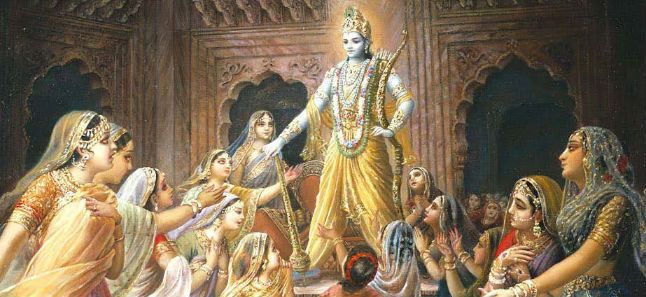
The word naraka means hell and Krishna is the enlightened human who kills this demon, Naraka. He destroys the hell of misery we have created for ourselves within our minds due to our lack of understanding of our true nature. He frees the spirits of positivity which have been shut up within the prison of our ignorant mind and marries them (allows them to unite with him). The enlightened being will destroy the hell of ignorance in his mind which in turn throws open the door to many positive qualities which have been jailed inside. His true nature or home within himself has now been lit up with all positive qualities. Symbolically we light thousands of lamps in our houses trying to remove the darkness of the night outside but our hearts are still choked with the darkness of intolerance, fear and hatred. In fact this darkness has covered the whole world defying all attempts by right minded people. The festival of Diwali celebrated every year is a continuous reminder to us to kill this demon and set free the positivity which is enshrined in us. On this day, Hindu merchants in North India open their new account books and pray for success and prosperity during the coming year. They do puja to Lakshmi the goddess of wealth and invite her into their homes. New clothes are distributed to the poor and of course to all members of the family. This year Amavasya, or the new moon in the month of Kartika falls on the 28th of October. This is said to be the darkest night of the year. This is the third day of Diwali. On this day devotees worship Lakshmi, the goddess of prosperity when she is in her most benevolent mood, ready to fulfil the wishes of her devotees. It is said that this was the day on which she was born and also the day on which she married Vishnu. The same theme is repeated in the Ramayana. Rama kills the demon Ravana and returns to his own city of Ayodhya along with his wife Sita after fourteen years in exile, on the night of the new moon. The citizens await his return and welcome him with thousands of little lights. Here Ravana is the epitome of the unbridled ego which has to be vanquished by Rama, the man of enlightenment. Rama rescues his beloved wife Sita who is the epitome of all positive traits like purity, spirituality and unadulterated love. Re-enactments of the Ramayana, the story of Lord Rama, are part of the celebrations in some areas. The 4th day is known Bhaidooj in North India in which married girls return to their ancestral homes in order to celebrate with their brothers. This year it falls on the 29th October. Again and again the theme of the ignorant mortal who is covered with abysmal nescience is repeated every year in the hope that one day the light of clear reason will prevail and humanity will realise that the solution to all its problems can be found by clearing the ignorance in their own hearts. The divine Self is ever residing in our hearts and ever ready to give us all help if we turn to Him. Since He has given us a certain amount of intelligence, He allows us to make our own choices until the day dawns then we realise that we are truly incapable of making the right choices and then we turn to Him out of our own free will. At that time He will come running to our aid like Krishna did to help the princesses who had been jailed for many years. Firecrackers are a must for Diwali. Apart from the fact that people especially children love crackers, there is a scientific reason. Diwali comes straight after the monsoons when a lot of insects and mosquitos are flying around. The fumes produced by the firecrackers will kill or repel many of these unwanted insects. Above all Diwali is the victory of our noble emotions over our negative tendencies. May this Diwali allow each one of us to cast off the shackles of ignorance which have tied us down for lifetimes, free us from the choking chains of the demonic ego of Naraka and allow us to attain union with Krishna, the Purushottama, the Supreme Person, who alone can engulf us in the glorious light of eternal freedom which is ever existing in our hearts. Hari Aum Tat Sat 9/6/19
ONAM
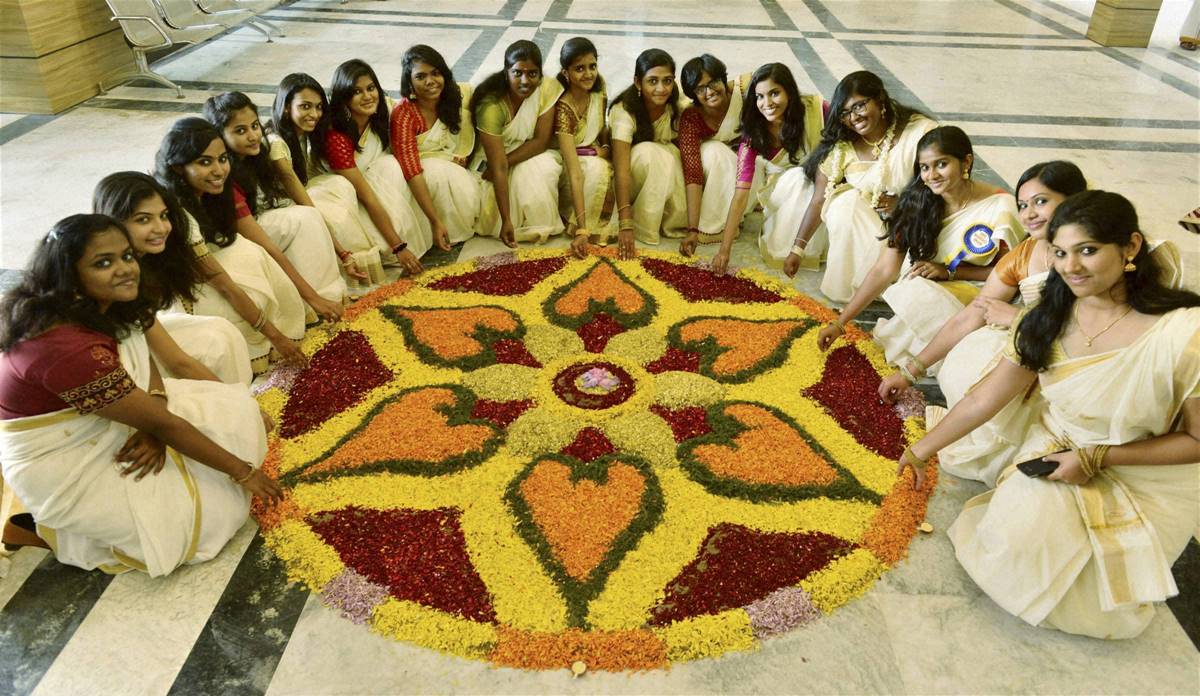
Lord Vishnu is the harmonizer in the Hindu Trinity made up of Brahma, the creator, Vishnu, the harmonizer and Shiva, the destroyer. Vishnu is supposed to have taken ten incarnations to uplift the world and free it from the thralldom of adharma or unrighteousness. The whole festival of Onam centers round the story of the fifth incarnation of Vishnu known as Vamana. But unfortunately this part of the Onam festival was forgotten during the days of the British rule. Now with the revival of Hinduism this story is slowly being brought into prominence. The fascinating story of the legendary king called Mahabali is closely connected with the Onam festival. Let us go back in history to the Titan known as Hiranyakashipu who was Mahabali’s great-grandfather. He was indeed a true asura (demon) who had sworn to erase the memory of Vishnu from his land and told everyone that he was both king and god (le roi et dieu). His son, Prahlada was a great Vishnu bhakta (devotee) and when Hinranyakashipu tried to kill him, Vishnu took the incarnation of Narasimha (man-lion) in order to save him. The modern city of Ahobila in Andhra Pradesh is the place where Narasimha is supposed to have incarnated himself. There are temples there to all the different aspects of Narashimha. Strangely enough Lord Vishnu took two incarnations to bless this family even though they belonged to the asuric (demonic) clan. When Prahlada took over the reign of the land he put
an end to all adharma (unrighteousness) and the land flourished and
everyone had devotion for Vishnu. His son was Virochana who was also a
great Vishnu bhakta. Bali was his son and he too inherited this
deep love and devotion to Vishnu. His guru was Shukracharya who
gave him all the knowledge necessary to become the greatest ruler of
this earth. He had inherited his father’s kingdom which was in the
Deccan plateau, now known as Andhra Pradesh and he had extended it to
include modern Maharashtra and even towards the north-eastern states.
The land prospered and flourished under his rule and everyone loved him.
However too much affluence always corrupts people’s minds and soon they
started to fall from the ancient Vedic concepts of dharma and good
behavior. King Bali felt sad at this insidious corruption that was
creeping into his realm and with the advice of his guru Shukracharya, he
decided to hold one hundred Ashwamedha Yagas (special fire ceremonies)
in order to bring the citizens back to the Vedic way of life. 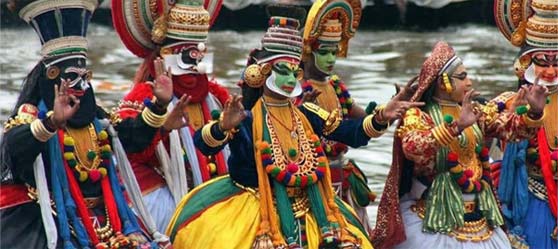 Onam Festival In the meantime the gods under their king Indra went
to Vishnu and begged him to do something about this kingdom that had
been flourishing with noble people at one time and had now become
totally corrupt. Vishnu agreed and took birth in a Brahmin household on
the full moon day of the month of Shravana (August/September) under the
star known as Shravana which is called Thiruvonam in Malayalam (the
language spoken in Kerala). Soon after his birth he took on the form of a
seven-year old boy. The little boy was called Vamana due to his
dwarfish size. He was invested with the sacred thread and given all the
accoutrements of a Brahmachari or a celibate student. He held a begging
bowl in one hand and a leaf umbrella in the other and was asked to go
and beg for his food as is customary for a Brahmachari who had just been
invested with the holy thread. At that time King Bali had just
completed his 99th Ashwamedha Yaga and was preparing for the
100th. Vamana set out purposefully towards the palace but it is
said that at every step he took the whole of the earth shook as if to
proclaim his future grandeur. Such was the splendour emanating from
Vamana, that when he reached the court where the king, sages and other
great souls were assembled, King Bali, even though he was the emperor of
all the worlds stood up to welcome him. He rose from his throne and
went forward to receive him and gave him a seat of honour. The king felt
his heart surge with love for this small boy and told him to ask for
anything he wanted and he would surely give it to him. His guru
Shukracharya had some suspicions about the boy’s identity and called the
king to a side and warned him not to agree to Vamana’s request since he
suspected that he was none other than Vishnu sent by Indra to cheat
him. When he heard the name “Vishnu”, Bali’s heart jumped with joy and
for the first time in his life he disobeyed his guru and told him that
he was indeed honoured to have Vishnu come and beg from him and he would
certainly give him whatever he wanted. He asked the child what he
wanted. Actually Vishnu loved him very much but he had decided to put
him down so that the land would revert to its former glory so with a
side-long glance Vamana said that he wanted only three steps of land.
Bali roared with laughter and said, “I thought you were an intelligent
boy but I see now that you are only a child. You have come to the palace
of one who owns the whole earth and you are stupid enough to ask for
only three steps of land”.
The king agreed and proceeded to solemnise the promise with some water which he took in the palm of his hand as was customary. He was all set to pour it into Vamana’s little palm when he was stopped by Shukracharya, his guru (spiritual guide). “Oh King!” he said, “This little boy is none other than Vishnu who has been sent by the gods to defeat you. It is some trick. Do not give him anything!” The king replied, “I deem it a great honour that Vishnu, the great god of all the worlds has come to beg from me. Moreover, I will never go back on the promise I made to anyone even if it means death for me!” Vamana was very happy to hear these wonderful words coming from the mouth of this asura , who he felt was truly his devotee. Suddenly, the little body of the dwarf started to enlarge until it became a gigantic figure whose head could not be seen since it soared above the earth. With one step he measured the whole earth and with the other, all the interim space. Then in a thunderous voice he boomed, “Where is the third step that you promised me O Bali!” Without turning a hair the king whispered, “O Lord if you will only return to your original size you can place your little foot on my head and thus enable me to keep my promise of giving you three steps of land”. Vamana promptly returned to his original size and placed his sacred foot on the bowed head of the great king who was determined to keep his promise despite all odds. He pressed his little foot down on the crowned head of the king and sent him along with his retinue to the nether world where he was installed as the sole emperor. Vamana blessed him and said, “From now on you will be known as Maha-bali (the great Bali)! You are indeed a noble soul and will be known as one of my greatest devotees even though you have been born in the clan of the asuras (demons). I have great admiration for you and I promise that I myself will become your gate keeper and see to it that no enemy shall ever conquer you”. Mahabali then begged him to be allowed to return to
the land he loved at least once a year. Vamana agreed and it is said
that Mahabali returns every year on Thiruvonam day to his land to bless
his people. Of course, he is always accompanied by Vamana who comes
before him to make everything ready for his arrival. Because of this
both the asura king Mahabali and Lord Vishnu as Vamana are welcomed by
the Keralites during Onam. This makes Onam a unique festival in which
the victor and the vanquished are both worshipped at the same time. The British derided us since they said we had no written historical records. This statement is true in one sense because our history goes way back to the times when the written word was unknown. Western history is only a boring account of all their kings and heroes, written by people who lived long after the kings were dead and gone. Our history which goes beyond the so called historical times, was captured in the hearts of the people. It is to be found in the very cells of the people of this country so that it was always a living thing and not a set of moth eaten books left to rot in a library! It was woven into the very fabric of our lives and every festival we have is a celebration of some part of our history. Our history was told and enacted through the centuries by the bards and the various “kathas” (story telling of the Puranas) that take place in temples so that despite the continuous foreign invasions it was kept intact in the heart and mind of the nation. It is a living thing bringing joy to all those who listen to it even though these incidents took place centuries ago. It’s not a boring account of people who died eons ago and whose lives are only to be found in the pages of a book! Our history still continues to inspire us to perfect ourselves as the heroes and noble kings of ancient times. Even though these stories are considered as mythological due to foreign influence the fact is that they all have some basis in our ancient history. Now when we look at the stories woven round the
festival of Onam we will come up with a practical problem. First of all
the history of Kerala does not record a king called Mahabali. Secondly
Vamana was the fifth incarnation of Lord Vishnu and Kerala is supposed
to have been carved out of the ocean by Parashurama who was the sixth
incarnation. So how can we clear this discrepancy? 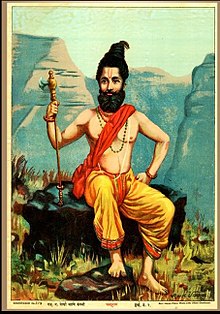
For this we will have to delve into the past history of Kerala which goes back a few thousand years. Parashurama was the son of the great sage called Jamadagni. Once the powerful king Kartavararjuna came to his ashram and totally destroyed it and killed the sage in the process. His son Parashurama was incensed and swore to avenge the death of his father and started an ongoing process of decimating all the haughty kshatriya (warrior caste), rulers of the country. At last he came to his senses and stopped the senseless slaughter. He was anxious to get divine pardon for his crimes. He was told that the only way was to donate land to Brahmins and provide a safe place for them to live as they had no one to protect them since all the kshatriyas had been killed. He did intense tapas to Lord Shiva at the place called Gokarna which was then the tip of this country. Shiva told him to placate Varuna, the Lord of the waters who would be able to give him some land. Varuna was pleased and told him to throw his axe as far as he could into the ocean and reclaim the land from the sea. He threw his axe with all his might into the ocean and the land called Kerala was born. (It is to be noted that the coast line of India has been changing during the centuries. Sometimes the sea claimed some of the land and sometimes it threw up the land due to seismic movements in the bottom of the sea.) Parashurama then brought thousands of Brahmins from Andhra Pradesh, the land of Mahabali and established them in this new land and gave them everything they needed. He also made many Shiva and Durga temples in the land so that it became a beautiful, spiritually charged place. Afterwards many artisans and other types of workers came to the place. Historically we know that the Narasimha avatara took
place in the town called Ahobila in Andhra Pradesh and therefore
Vamana’s avatara would obviously have taken place there, since that was
Mahabali’s country which was his legacy from his great-grandfather,
Hiranyakashipu. However the fact is that the Brahmins who came
from Andhra Pradesh brought with them the memory of their great king
Mahabali who had promised to return to their land once a year on the
birthday of Vamana which falls on the star called Shravana in the month
of Chingam (August/September). The Malayalam name for Shravana is
Thiruvonam so this is how the festival of Thiruvonam started in Kerala
even though Mahabali was never a king of Kerala!! Their history
travelled with them! As the centuries rolled by, people forgot where they
had come from and started to believe that Mahabali was indeed one of
their kings and that Vamana had taken his incarnation there in the
country of Kerala. To corroborate this belief they built a temple to
Vamana, known as Trikkakara in the town of Trippunithura in the
Ernakulam District of Kerala. The name is derived from the word
“Trikkal” or “holy feet” of Lord Vishnu as Vamana when his feet touched
the earth. The idol of Vamana was installed in this temple centuries ago
possibly by Parashurama himself. It was called Trikal-kara at one time,
meaning the place of the “holy feet” but degenerated into
Trikkakara. This is the historical background of the festival of
Onam which is celebrated to honour the fifth incarnation of Vishnu known
as Vamana and to show the greatness of the king who kept his promise
even though he knew that great harm might come to him. This is the
attitude which all rulers of any country should have, to keep the
welfare of their people before their own and to keep the promises made
by them to the citizens of the country they rule! Hindus follow the lunar month made up of twenty-eight days. On each day of every month one star will be in ascendance. A lot of importance is given in our horoscopes to the star on which we are born. That is what decides our physical and mental qualities. The word Onam is a shortened form of Thiruvonam which is the Kerala version of the star known as Shravana in Sanskrit. As mentioned earlier, Vishnu in his form as Vamana was born on this day, the full moon day of the month of Shravana on the star called Shravana or Thiruvonam. On the eve of Onam when the star known as Uttradam (Uttaraphalguni) is in ascendance all Hindu houses in Kerala invite Lord Vishnu in his form as Vamana to come and bless their house. A pyramidal clay figure with four sides and a flat top is made and this is known as Trikkakarappan or the Lord of the temple of Trikkakara who is Vamana. This unique four-sided figure is supposed to represent the four stages in the life of the human being. In modern days when people have no access to clay, we find that these structures are made of wood and sold in shops. The little idol of Trikkakarappan is placed on a banana leaf on which mystic symbols have been drawn with rice flour. It’s normal to make two smaller versions of Trikkakarappan and keep them on either side of the main idol. These three idols are supposed to represent the three steps of land taken by Vamana. The festival begins ten days before Thiruvonam on the star called Hastha or Attham. From that day onwards, children collect wild flowers and make lovely floral arrangements outside the house. This is called a “pookkalam.” Each day of the ten-day festival is represented by a special “pookkalam”. Originally the pookkalam consisted of ten concentric rounds. These ten circles were meant to represent the ten avataras or incarnations of Lord Vishnu. On the first day called “attham” the “pookkalam” would only have one round, the next day it would become two rounds and finally on Tiruvonam day it would have ten rounds. On the first day the round would be made of one single colour, on the second day two colours and so on till the final day when ten colours were used. Nowadays this tradition is rarely followed, and more importance is given to the design and variety of flowers. People buy bunches of flowers in the market and make huge “pookkalams” of every size and shape and even use coloured powders as they do in the “rangolis” (designs made with coloured powders) in N. India. One of the most famous events during this season is
the Aramula snake boat race. The boats are long and sleek and have the
head of a snake carved in front. There are about two hundred rowers and
the incredible thing is the way they keep to the rhythm that is beaten
on a drum by the man standing at the head of the boat. If even one
person makes a mistake the boat will falter and they will lose the race.
Hence this is a true picture of how a country can prosper only if all
the citizens row to the rhythm played by the head. The race starts from
the famous Sri Krishna temple at Aramula. This is the glorious tradition of the land of Kerala and every Onam is a fulfillment of the promise made by Vamana to help them provided the rulers kept their promises to their citizens like Mahabali. Unfortunately the recent events in Kerala have shown that the present rulers are far from being the greatest. In fact they are doing their best to disrupt the spirituality of this land and are bent on harming the Hindus exactly as Hiranyakashipu, the great-grandfather of Mahabali had done long ago. Let us hope that with the blessings of Vamana the beautiful land of Kerala will revert to its past glory, and the people will get a set of rulers who will keep up the tradition of the Great Bali -Mahabali. Hari Aum |